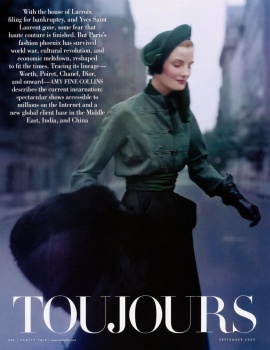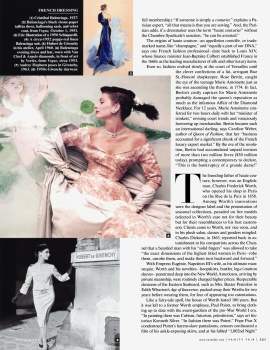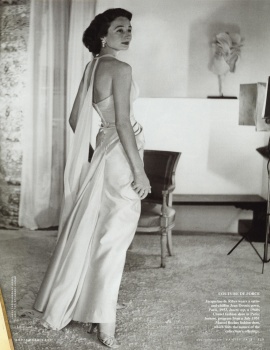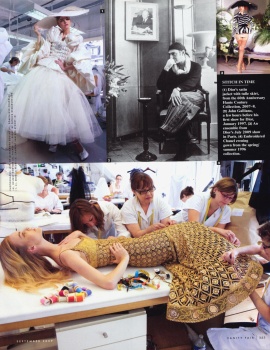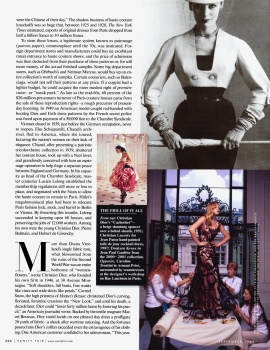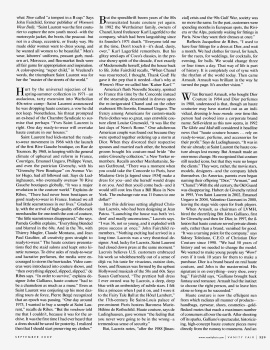SomethingElse
Press escape to continue.
- Joined
- Mar 22, 2007
- Messages
- 5,444
- Reaction score
- 0
13 August 1934
time.com
Not for three months will the horse chestnut trees on Paris' Champs-Elysees begin to turn yellow. Yet last week on the brief and severe Rue de la Paix autumn had already come. And on hand for its coming was an excited little army of U. S. dress buyers who crowded through closely-guarded doorways into the salons of the great Parisian couturiers. Inside the warm air was heavy with perfume and the smell of new silk. Buyers who usually paid $100 to get in (refunded on the first order) cocked their heads and adjusted their glasses as the sleek mannequins rustled to ward them in long-skirted evening gowns, sport dresses with Brazil nuts for buttons, coats made of steamer rugs, woolen dresses with oilcloth grapes. Soon the buyers would stream out of the city with notes and gossip on the fashions Paris was about to set the world for the winter of 1934-35.
To Parisians the excitement from the Etoile to the Rue de la Paix was an old story. As every fashion follower knows, there are two months in the year — February and August — when the couturiers throw open their shops to a select few to reveal in their "collections" what the best dressed women will wear during the next six months. Smaller midseason displays are held in April and November.
Present at last week's openings, to which admittance was by card only, were four types of people: 1) a few celebrated European socialites, who as private customers may be expected to buy a half-dozen gowns; 2) reporters and fashion writers; 3) manufacturers, many from the Americas, who will buy gowns as models and sell copies wholesale to every little dress shop; and, most important, 4) buy ers from big U. S. department stores, Altman, Macy, Saks Fifth Avenue, Bonwit Teller, scores of others. There is no competitive bidding between buyers and the price is the same to all couturiers who will make up any number of duplicates of a favorite model.
To supply its customers with Paris copies, a department store, through its buyer at the opening, will purchase a variety of original models and import them into the U. S. under bond. If the model is returned to France within six months, the store does not have to pay any U. S. duty on it. During that period the store turns the Paris gown, which may have cost as much as $1,000, over to its private manufacturer to make, say, 50 copies to sell at $69.50. The store is at liberty to advertise its 50 dresses as copies of Chanel or Schiaparelli or whatnot. Then the original dress is shipped back to Paris and the department store gets a refund on its customs. In Paris the soiled model is peddled to some small back-street dress shop which sells it sometimes for as little as $10.
The topnotch independent clothing manufacturer whose buyers have also attended the Paris openings follows the same routine, except that he usually makes thousands of copies and sells to smaller retail stores. He it is who is responsible for the fact, that, within 30 days of the original showings, every shopgirl in the land is wearing a cheap imitation of what is the best Paris style.
To get their news of last week's openings, most big U. S. department stores were in constant cable communication with Paris. B. Altman & Co. went a step further, with a transatlantic telephone service. This scheme was originated last year by Altaian's top Fashion Copywriter Laura Hobson. Young, smart Advertising Director John C. Wood planned to launch a display campaign in newspapers and magazines this week to publicize the new designs. The trends of fashions as Altman and other stores studied them last week: There are three predominant silhouets —medieval, crinoline, Empire. Empire features long toe-length skirts and extremely high waists to emphasize the curve of the bosom. The crinoline type, adorned with bows and puffs, has a hoopskirt effect. The ecclesiastic medieval silhouet, which fashion experts predict will be the most popular, emphasizes slim waists, full sweeping skirts, and necklines either demurely high or wickedly low. But since it is impossible to look ecclesiastical in feathery chiffon materials, the medieval silhouet is certain to have far-reaching effects upon the fabric world. Dresses of this type must be made of stiff velvets, bulky slipper satins, heavy faille taffeta.
Tweeds have come off the golf course into the drawing room, are now correct for tea. Reason: the informal shirt waist has been supplanted by blouses of stiff velvet, chenille, soft duvetyn.
Furs are used extensively for trimming and edging, but big fur collars are frowned upon. Most amusing fur note is an Astrakhan muff shaped like a dachshund. Hats, also exotic, feature the stovepipe which sits high on the head, the Francois Villon, and the tiny velvet head turban with three and only three feathers. Skirts are split, but not notably longer than last year, varying from floor length to 15 in. above the floor. Trains are conspicuously absent. Predominant dress colors are black, "poison" green, purple.
time.com
Last edited by a moderator:

















 Great Information! Very interesting
Great Information! Very interesting i just printed so i can start to read it !!
i just printed so i can start to read it !! 